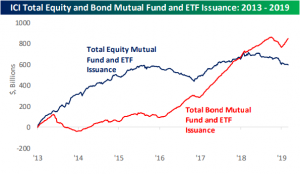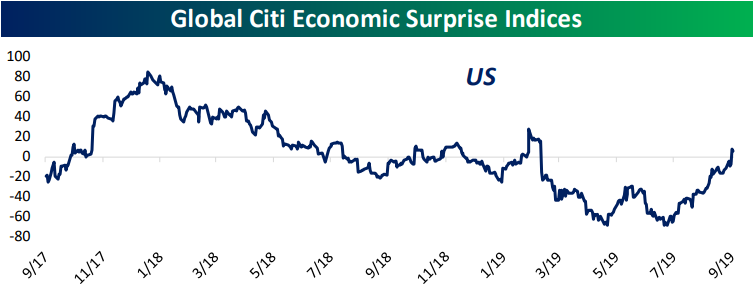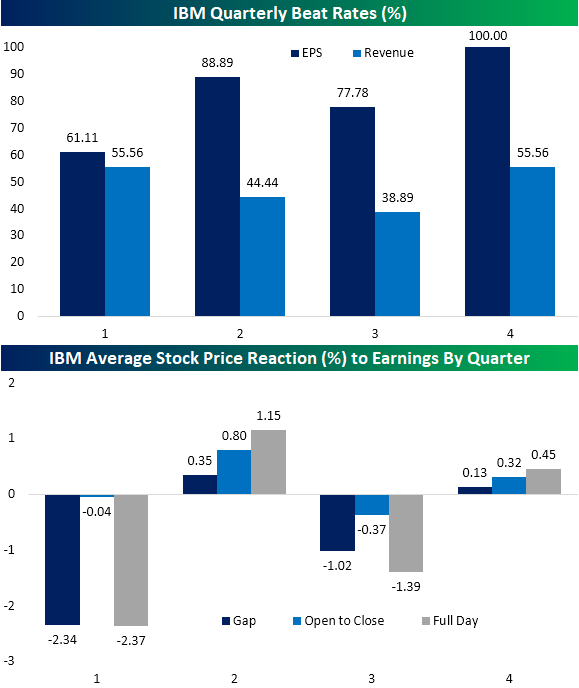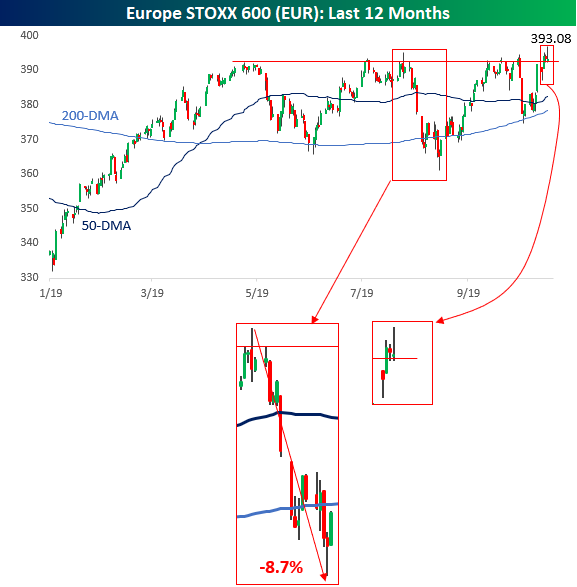The Closer: End of Week Charts — 10/18/19
Looking for deeper insight on global markets and economics? In tonight’s Closer sent to Bespoke clients, we recap weekly price action in major asset classes, update economic surprise index data for major economies, chart the weekly Commitment of Traders report from the CFTC, and provide our normal nightly update on ETF performance, volume and price movers, and the Bespoke Market Timing Model. We also take a look at the trend in various developed market FX markets.
The Closer is one of our most popular reports, and you can sign up for a free trial below to see it!
See tonight’s Closer by starting a two-week free trial to Bespoke Institutional now!
Bonds Bounce Back In Fund Flows Data
The week ended October 9th saw relatively large inflows into bond funds and relatively large outflows from equity funds. Across all mutual and exchange traded funds, equity flows were in the 7th percentile of all readings since 2013, with outflows of $11.5bn. Of that total, $5.8bn was ETFs, with the lion’s share of equity fund outflows coming from domestic funds. As has so frequently been the case lately, bond funds were the exact opposite situation. Total bond fund flows across mutual funds and ETFs meant $5.8bn of new cash on the week, which is in the 64th percentile of all periods. ETFs were relatively stronger, with bond funds drawing $1.9bn of inflows, higher than more than 81% of periods since 2013. Within both ETF and combined mutual and ETF flows, municipal bonds were the standouts, with total flows in the top 10% of all periods. Since 2013, $152bn has flowed into mutual funds and ETFs that own municipal government bonds, with more than $90bn of that coming since the end of 2017. Those flows are very likely being driven by tax-advantaged buying incentivized by the changes to the tax code at the end of 2017 which ended a variety of popular state and local tax deductions. Start a two-week free trial to Bespoke Institutional to unlock access to our actionable research and interactive tools.
ISM Offsides, If Not Utterly Incorrect
This week’s manufacturing activity releases from the New York Fed and Philly Fed showed a slightly weaker but generally upbeat assessment of economic activity. The numbers from these two regional surveys may not be fully representative of the aggregate national economy, but they’re usually a pretty good indicator. As shown in the chart below, they’ve been a decent guide to what the ISM Manufacturing index says about national activity since the Empire State manufacturing index started its releases in 2001.
Unlike these two indices, which have shown a general uptick in activity over the last few months, the ISM index shows a different route. But that data isn’t backed up by the average results across the five Fed districts that survey their manufacturers. The size and scale of the divergence is so big that one of these indices is almost certainly wrong, but which?
For a tiebreaker, Markit’s manufacturing survey suggests conditions are at multi-month highs and picking up, more consistent with the data from Fed surveys than ISM. Markit’s sample size is bigger and the index is more representative of the whole sector than ISM only; with all five regional Fed surveys in the mix, they also have a sample size advantage over ISM. Hard data of late (including manufacturing production, exports, and hiring) has all sided against ISM and is showing data more consistent with the Five Fed or Markit surveys. For now, it looks like the brutal ISM results are a bit overstated. Start a two-week free trial to Bespoke Institutional to unlock access to our actionable research and interactive tools.
Moving Abroad?
While the title may suggest it, this isn’t a political post geared towards Democrats who can’t stand President Trump or Republicans fearing the prospect of a President Warren or Sanders. What we’re talking about here is what could be early signs of a break in the nearly decade long trend of international stocks underperforming equities in the United States. The first chart below shows a long-term look at the relative strength of the MSCI Ex-US Index versus the S&P 500 going back to 1999. When the line is rising, it indicates outperformance on the part of international stocks (ROW), and when it is falling, US equities are outperforming.
While the first several years of this century were dominated by outperformance on the part of international stocks at the expense of the S&P 500, that trend reversed with the Global Financial Crisis as international stocks had given up all of their outperformance by 2012, and then continued to lag going forward. The lower chart shows a closer look at the relative strength between the two indices over the last year. Here, it has been mostly more of the same. Outside of a brief surge during the Q4 market rout late last year, ROW has underperformed the S&P 500 for pretty much all of 2019. That is up until recently. Since late August, the relative strength line of the ROW has actually been drifting higher. Granted, it’s not a major shift at this point, but you have to start somewhere, and as of now ROW’s relative strength is near a four-month high.
For emerging markets (EM), the trend has been nearly identical to that of the ROW. The charts below are the same as the ones above, except instead of the MSCI World Ex-US index, we substituted in the MSCI Emerging Markets Index. Here, it’s been a similar story as relative strength in EM peaked just after the Financial Crisis and has been drifting lower ever since. While EM hasn’t given up all of its outperformance from the earlier part of this century, it has given up most of it and is now right near multi-year lows. Like the picture for ROW, though, it’s still early, but in the last couple of months, the relative strength for EM has been slowly drifting higher and is now near three-month highs. Start a two-week free trial to Bespoke Institutional to unlock access to our actionable research and interactive tools.
Dividend Stock Spotlight: International Business Machines (IBM)
After Wednesday’s close, investors got third-quarter results from blue-chip technology giant International Business Machines (IBM). Consensus analyst forecasts were calling for EPS of $2.66 and revenues of $18.285 billion. While IBM beat EPS by two cents, revenues were more than $250 million below forecasts and down 3.9% year-over-year (the fifth straight quarter with revenues lower than the previous year) even with the boost from newly acquired cloud computing company Red Hat which had stronger revenues In reaction to this miss at the top line, IBM’s stock declined 5.52% in trading on Thursday on elevated volumes.
Putting this week’s report into historical context, Q3 has been one of the weakest quarters in terms of beat rates as well as stock price reaction for IBM. Since 2000, IBM has only reported better than expected revenues in Q3 38.89% of the time, the lowest of any quarter. The EPS beat rate of 77.78% could also be better but is better than Q1’s 61.11%. Given this, Q1 and Q3 stock price reaction to earnings have been less frequently positive with IBM’s stock rising only 22% and 33% of the time, respectively. Q1 has actually been the weakest quarter as IBM has averaged a full day decline of 2.37%, most of which comes at the opening gap. Q3 is the next weakest quarter with an average decline of 1.39%. In other words, while yesterday’s decline was larger than expected, it is not unusual for the stock to be weak in Q3.
As a result of Thursday’s decline, IBM traded down through both its 50 and 200-DMA and now trades at the lower end of the past year’s range. The decline also pushed IBM’s dividend yield up to 4.83%, which is the highest yield of all S&P 500 technology stocks. It also has the third-highest yield of the 30 Dow stocks behind only Exxon Mobil (XOM) and Dow (DOW). Although the payout ratio is around the highest levels of the past 20 years at 85.8%, meaning further dividend growth given the slowing pace of revenues could come into question, 2019 marked the 24th consecutive year that IBM raised its dividend. Given this, if IBM raises the dividend again in 2020, the stock could potentially join the Dividend Aristocrats—a group of stocks with 25+ straight years of a growing dividend. If this were to happen, IBM would join Automatic Data Processing (ADP) as the only Technology stocks in the group. Additionally, at current yield levels, IBM would also be the fourth-highest yielder of the Dividend Aristocrats, behind AbbVie (ABBV), AT&T (T), and Exxon Mobil (XOM). Start a two-week free trial to Bespoke Institutional to access our interactive chart screens and much more.
Nasadaq – One Downtrend Down, Another To Go
In a post yesterday, we discussed the seemingly never-ending rangebound trading pattern for the STOXX 600. It’s not just Europe either. Seemingly everywhere you look these days, there’s a major equity index stuck in some sort of range. The Nasdaq is just one example of many. At a level of around 8,140, the Nasdaq is at the same level it was at exactly six months ago and also all the way back in August of last year.
Last week at this time, things were looking good for the Nasdaq as the index had bounced off of support at its 200-DMA and broke its short-term downtrend from the September lower high. This week has seen further gains with the Nasdaq rising more than 1%, but that rally looks to have stalled out yesterday right at another downtrend from the July high. A meaningful break of that downtrend would come into play at around 8,200 which is just over half of one percent above current levels. Using our Trend Analyzer tool, of the 100 stocks in the Nasdaq 100, heading into today, 43 were overbought and just five were oversold, so it may take a few days of ‘rest’ for the index before a meaningful break of that downtrend can occur. Start a two-week free trial to Bespoke Institutional to unlock access to all of our interactive tools.
Bespoke’s Morning Lineup – 10/18/19
See what’s driving market performance around the world in today’s Morning Lineup. Bespoke’s Morning Lineup is the best way to start your trading day. Read it now by starting a two-week free trial to Bespoke Premium. CLICK HERE to learn more and start your free trial.
The Closer – Europe Rejections, Construction Cruising, Manufacturing Divergence – 10/17/19
Log-in here if you’re a member with access to the Closer.
Looking for deeper insight on markets? In tonight’s Closer sent to Bespoke Institutional clients, beginning with a technical note, we show the resistance European markets have run into and the breakdown in the dollar. Moving onto economic data, we show the pause in September home construction data. We then provide an update to our Five Fed Manufacturing Composite, including the massive divergence between the Empire and Philly Fed’s indices with ISM. We finish with a look at today’s EIA data.

See today’s post-market Closer and everything else Bespoke publishes by starting a 14-day free trial to Bespoke Institutional today!
Bespoke’s Sector Snapshot — 10/17/19
Rangebound on Both Sides of the Atlantic
Everyone here is well aware of the fact that equities have been stuck in what seems like an endless trading range where the S&P 500 has failed to break out meaningfully to new highs. What some investors may not be of cognizant of is the fact that over in Europe, the benchmark STOXX 600 has also been stuck in a trading range of its own. While the index peaked at higher levels in 2015, it subsequently fell over 25% during the global sell-off in late 2015/early 2016. From those lows, the STOXX rallied more than 30% for the next 15 months. Since May 2017, though, the index has been stuck in a range and unable to meaningfully break out to new highs.
This year’s performance for the STOXX 600 has been a continuation of the holding pattern that the index has been stuck in since 2017. Earlier today, it looked as though we were getting close to a breakout as the index hit a 52-week high, but late in the European session equities sold-off nearly 1% from the intraday highs finishing near the lows of the day. Oh well. Maybe tomorrow.
What bulls in Europe are hoping is that today’s late-day sell-off isn’t a repeat of what happened on July 25th. Back then, we saw a similar-looking breakout, but like today, the gains didn’t hold and the STOXX 600 reversed over 1% and finished near the lows of the day. From the high on the day of that failed breakout in late July to the August lows, the STOXX 600 went on to fall nearly 9%. Start a two-week free trial to Bespoke Institutional to access our actionable research and interactive investment tools.







